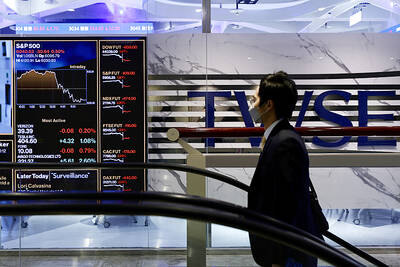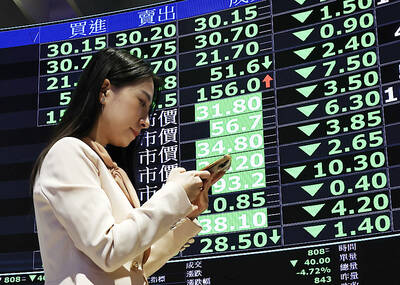The nation’s major suppliers of memory chips and modules saw their stock prices climb by up to 9.97 percent yesterday amid speculation that Samsung Electronics Co plans to raise mobile DRAM prices by about 10 percent on the back of increasing supply constraints.
Adata Technology Co (威剛科技), the world’s second-largest memory module supplier, outperformed its peers as its shares skyrocketed near the 10 percent daily limit to NT$86, or up 9.97 percent.
The performance marked its highest level in more than three-and-a-half years.
Turnover set an all-time high, with 40 million shares changing hands, Taipei Exchange statistics showed.
The company on Friday said that the supply crunch in DRAM chips next quarter might exceed its expectations as increasing demand for smartphones and cloud-enabled servers is squeezing DRAM chip supply.
That would pave the way for another round of price hikes through early next year, it said.
On the demand side, Chinese mobile phone vendors Oppo Mobile Telecommunications Corp (歐珀移動) and Vivo Communication Technology Co Ltd (維沃移動通信) are snatching up memory chips in preparation for product launches next quarter, the Economic Daily News reported yesterday.
The increased buying is adding pressure to the already short supply, it added.
As its supply cannot keep pace with demand, Samsung informed original equipment manufacturers early this quarter that prices for DRAM chips would increase about 10 to 15 percent sequentially, the report said.
DRAM prices have been spiraling upward since the second half of last year, as the world’s top three memory chip makers keep a tight rein on capacity expansion, it said.
Samsung, SK Hynix Inc and Micron Technology Inc are expanding DRAM capacities by migrating to next-generation technologies, while investing heavily in boosting flash memorychip capacities, the report said.
The news also helped boost shares of the nation’s major DRAM chip suppliers, Nanya Technology Corp (南亞科技) and Winbond Electronics Corp (華邦電子), which surged 5.7 percent and 7.14 percent to NT$79.8 and NT$27 respectively.
The rally helped push the TAIEX to a 27-year high at 10,631.57 yesterday.
To cope with rising demand, Winbond said it plans to invest NT$335 billion (US$11.13 billion) to build a plant, but it has not yet disclosed a time table for construction.
Market researcher TrendForce Corp (集邦科技) said that short supply of DRAM chips would continue through this year as global supply is to grow at a slower annual pace of 19.5 percent, compared with 25 percent annual growth in previous years.
However, market demand is growing much faster at 22 percent annually or more, it said.

SELL-OFF: Investors expect tariff-driven volatility as the local boarse reopens today, while analysts say government support and solid fundamentals would steady sentiment Local investors are bracing for a sharp market downturn today as the nation’s financial markets resume trading following a two-day closure for national holidays before the weekend, with sentiment rattled by US President Donald Trump’s sweeping tariff announcement. Trump’s unveiling of new “reciprocal tariffs” on Wednesday triggered a sell-off in global markets, with the FTSE Taiwan Index Futures — a benchmark for Taiwanese equities traded in Singapore — tumbling 9.2 percent over the past two sessions. Meanwhile, the American depositary receipts (ADRs) of Taiwan Semiconductor Manufacturing Co (TSMC, 台積電), the most heavily weighted stock on the TAIEX, plunged 13.8 percent in

A wave of stop-loss selling and panic selling hit Taiwan's stock market at its opening today, with the weighted index plunging 2,086 points — a drop of more than 9.7 percent — marking the largest intraday point and percentage loss on record. The index bottomed out at 19,212.02, while futures were locked limit-down, with more than 1,000 stocks hitting their daily drop limit. Three heavyweight stocks — Taiwan Semiconductor Manufacturing Co (TSMC, 台積電), Hon Hai Precision Industry Co (Foxconn, 鴻海精密) and MediaTek (聯發科) — hit their limit-down prices as soon as the market opened, falling to NT$848 (US$25.54), NT$138.5 and NT$1,295 respectively. TSMC's

TARIFFS: The global ‘panic atmosphere remains strong,’ and foreign investors have continued to sell their holdings since the start of the year, the Ministry of Finance said The government yesterday authorized the activation of its NT$500 billion (US$15.15 billion) National Stabilization Fund (NSF) to prop up the local stock market after two days of sharp falls in reaction to US President Donald Trump’s new import tariffs. The Ministry of Finance said in a statement after the market close that the steering committee of the fund had been given the go-ahead to intervene in the market to bolster Taiwanese shares in a time of crisis. The fund has been authorized to use its assets “to carry out market stabilization tasks as appropriate to maintain the stability of Taiwan’s

In a small town in Paraguay, a showdown is brewing between traditional producers of yerba mate, a bitter herbal tea popular across South America, and miners of a shinier treasure: gold. A rush for the precious metal is pitting mate growers and indigenous groups against the expanding operations of small-scale miners who, until recently, were their neighbors, not nemeses. “They [the miners] have destroyed everything... The canals, springs, swamps,” said Vidal Britez, president of the Yerba Mate Producers’ Association of the town of Paso Yobai, about 210km east of capital Asuncion. “You can see the pollution from the dead fish.